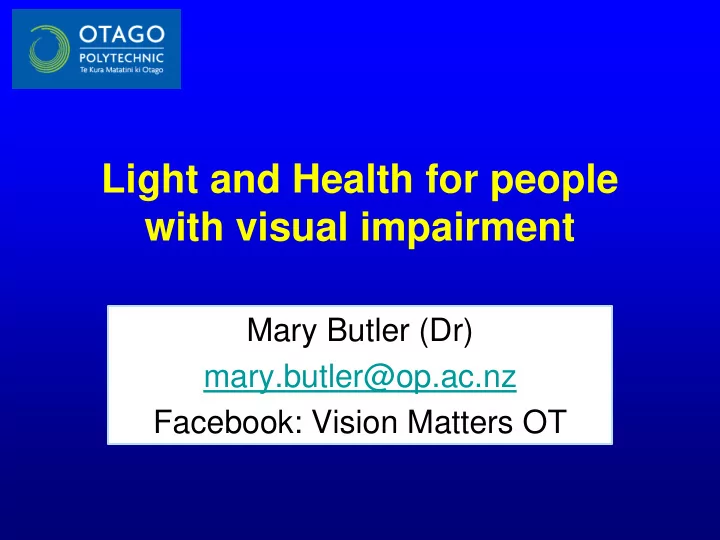

Light and Health for people with visual impairment Mary Butler (Dr) mary.butler@op.ac.nz Facebook: Vision Matters OT
Definition of low vision “Seeing the light and being guided by it”
Optometric changes with age • Reduced accommodation • Reduced retinal illuminance • Reduced contrast and colour saturation • Reduced ability to discriminate blue colours. + Visual impairment = Less light
Visual effects of light • Light is needed to trigger the cone cells on the retina, in order to read, to see details, and to do all tasks (including mobility)
As we get older, we generally need more light to read and to do near tasks • A 50 year-old likely needs 10 times as much light as a 10-year old to read • A 65 year-old likely needs 15 times as much light as a 10-year old to read • The VIP will likely need 3-4 times as much light as a person their age
Effects on function Light increases • productivity for VIPs • capacity to read without magnification • reading speed • ADLs Lack of light leads to • Reduced mobility (driving, community, going out in winter, getting lost, refusing adventure
Non visual effects of light Effects on • Circadian rhythm • General alertness • Vit D (osteoporosis) • Mood
visual + non visual effects of light = • Falls • Depression and social isolation • Sleep disorders
Care ethics • Attentiveness • Responsibility • Competence • Responsiveness (Tronto, 2002) 2016 study funded by PSP on Educating VIPs “How to read a light bulb”
Difficulties making changes • Physical • Personal • Cognitive • Emotional • Financial • Technical
Readiness to change Recognise problems with • Light • Function
Solutions 1. Will the lighting enable the occupant to move comfortably around the space/do the task? [Appropriate] ) 2. Will the lighting be sufficient for the activity/task and enable the person to move around? [Sufficient] 3. Will the lighting be even, avoiding shadows and sharp changes? Will lamps be hidden from direct view? [Even] 4. Will the lighting be separately switched or dimmed? Will there be appropriate window blinds and curtains? [Adjustable] 5. Will daylight be used whenever possible? Will energy efficient lamps be used? [Energy Efficient] 6. Will the lighting changes be done with minimal disruption? Can existing wiring and equipment be used? [Simple] 7. Will new lighting be adaptable to future changes in need? Would it be suitable for future occupants? [Future Adaptable] Pocklington Trust 2015
What is useful? • Lighting prescriptions • Workshops
References • Bakker, R., Iofel, Y., & Lachs, M. S. (2004). Lighting levels in the dwellings of homebound older adults. Journal of Housing for the Elderly , 18 (2), 17 – 27. http://doi.org/10.1300/J081v18n02_03 • Bowen, M., Edgar, D. F., Hancock, B., Boyce, P. R. (2003). Lighting for the elderly. Technology and Disability , 15 , 165 – 180. doi:10.1201/b16707-17 • Brown, M. J., & Jacobs, D. E. (2011). Residential light and risk for depression and falls: Results from the LARES study of eight European cities. Public Health Report, 126(Suppl1), 131-40. • De Lepeleire, J., Bouwen, A., De Coninck, L., & Buntinx, F. (2007). Insufficient lighting in nursing homes. Journal of American Medical Director’s Association , 8(5), 314-317. • Paul, S., & Yuanlong, L. (2012). Inadequate light levels and their effect on falls and daily activities of community dwelling older adults: A review of literature. New Zealand Journal of Occupational Therapy , 59 (2), 39 – 42 • Perlmutter, M, Bhorade, A, Gordon, M, Hollingsworth, H, Engsberg, JE & Baum, CM. (2013). Home lighting assessment for clients with low vision. American Journal of Occupational Therapy, 67, 674-681. doi: 10.5014/ajot.2013.006692 • Shikder, S., Price, A., & Mourshed, M. (2010). A systematic review on the therapeutic lighting design for the elderly. 18th CIB World Building Congress CIB W084 - Building Comfortable Environments for All, pp. 65-79. • Taylor HR, West S, Muñoz B, et al.(1992), The long-term effects of visible light on the eye. Arch Ophthalmol. Jan;110(1):99-104.
Recommend
More recommend